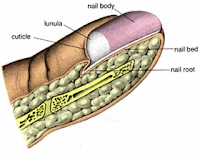The fingernail is an important structure made of keratin that has 2 purposes. The fingernail acts as a protective plate and enhances sensation of the fingertip. The protection function of the fingernail is commonly known, but the sensation function is equally important. The fingertip has many nerve endings in it allowing us to receive volumes of information about objects we touch. The nail acts as a counterforce to the fingertip providing even more sensory input when an object is touched.
Nail Growth
Nails grow all the time, but their rate of growth slows down with age and poor circulation. Fingernails grow faster than toenails at a rate of 3mm per month.It takes 6 months for a nail to grow from the root to the free edge. Toenails grow about 1 mm per month and take 12-18 months to be completely replaced.
Nail Structure
The structure we know of as the nail is divided into six specific parts - the root, nail bed, nail plate, eponychium (cuticle), perionychium, and hyponychium. Each of these structures has a specific function, and if disrupted can result in an abnormal appearing fingernail.
Fingernails: What to look for
| | |
Healthy nails are smooth, without ridges or grooves. They're uniform in color and consistency and free of spots or discoloration. Nails can develop harmless conditions, such as vertical ridges that run from the cuticle to the tip of the nail. Vertical ridges become more prominent with age. Nails can also develop white lines or spots due to injury, but these eventually grow out with the nail.
Not all nail conditions are normal, however. Some are signs of diseases that require medical attention. See your doctor if you notice these changes in your nails:
- Yellow discoloration
- Separation of your nail from the nail bed (onycholysis)
- Indentations that run across your nails (Beau's lines)
- Nail pitting
- Opaque or white nails
- Curled nails



No comments:
Post a Comment